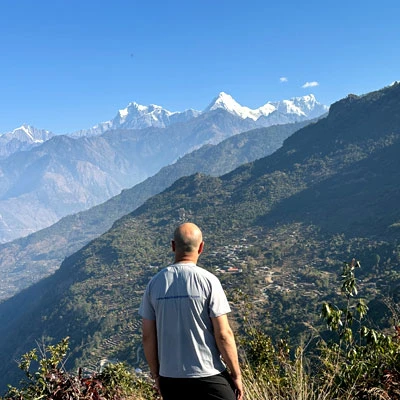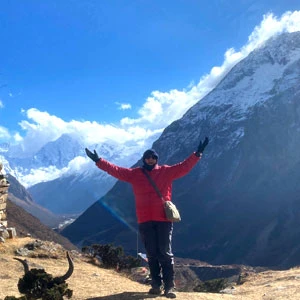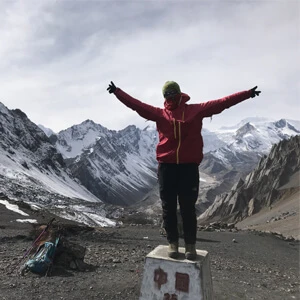The Best Season to Visit Nepal
Spring: From March to May:
Spring is a great time to come over and test your legs amongst the most spectacular mountains on the planet. With the temperature slowly rising from the depths of the harsh winter months, Nepal comes alive once more. Days are generally predictable, with nature ready to breathe fresh life into the hillside. Lakes chill out, and birds begin to welcome in the regeneration of what is to come.
Yes, spring is a great season. It is the time to see lush rhododendron forests in full bloom, cutting a blaze of color across the Himalayan foothills. Birding enthusiasts are in their element with many of the most beautiful birds gracing the trails. Treks at lower elevations (1000m to 3000m) are particularly appealing, especially if you have a young family. With virgin trails, there is plenty of time to relax and enjoy some wonderful days in the mountains.
At lower altitudes, mornings and evenings can be quite chilly before sunrise, and after the sun has dropped below the mountain peaks, it pays to have a layer or two at hand. The days are mostly sunny and pleasantly warm.
If you are planning to go higher, it is also a very good time to move on up the trail to get a more intimate experience of these mighty giants. With winter temperatures fading in the higher regions, there are some very tempting and vigorous days awaiting you on the trail. Temperatures are moderate with generally high skies along with clear, sunny, and warm trekking days.
Pros for Spring Trekking:
- Comfortable temperatures in the upper hills and lower mountain ranges. Between 18 and 23°C
- warmer days and warmer nights.
- On the higher altitude treks where snow has accumulated, trails are opening up as winter melts away. High mountain passes over 5000m come into their own; Cho La, Larke La, and Thorong La to name a few.
- less chance of flight cancellations into mountain regions, particularly if you are planning the Everest region.
- Quieter trails compared to the main autumn season of October and November
- Spring is also expedition season in Nepal when climbers from all over the world come to conquer their own personal challenges. This is a great time to mingle and share experiences as you trek alongside them, especially on the treks to Everest Base Camp and Manaslu Base Camp.
- The best opportunity to enjoy the religious color festivals Holi and Buddha Jayanti
Cons:
- As summer approaches, conditions can get quite hot and sticky at lower altitudes.
- There are possibilities of mountain clouds as the day builds; generally, nights and mornings are clear, providing some fabulous mountain views.
Recommended Treks in Spring
While Nepal offers a wide range of stunning trekking routes, it might be unfair to call it by a few names. However, we recommend the most satisfying and shouldn't miss it.
Off the Beaten Path Treks
Summer – From June to August:
Monsoon is a yearly visitor; the dates above are approximate. Sometimes the monsoon begins later and finishes later, but these dates cover the most intense period of rain in Nepal. Trekking over this period is significantly reduced, but as ever in Nepal, there are always people from all over the world on the trails. Temperatures are hot, especially at lower altitudes, with clouds and haze often limiting views. The landscape would be beautifully lush in summer, with brighter green fields, numerous cascading waterfalls, diverse flora and fauna, and much more fresh air.
Trekking at lower altitudes is still very possible and enjoyable on the better trails. It is also important to remember that it does not rain every day. We might encounter rain for a couple of hours in the afternoon and evening, which we can avoid by beginning our journey earlier in the morning. If you want to stay "rain-free," treks to the regions of Mustang and Dolpo are very tempting exceptions, as both lie in the rain shadow of Nepal. In general, peak rains occur in July; from the end of July onward, the rain begins to taper off as autumn approaches.
Pros for Summer Treks:
- You are in Nepal, one of the most compelling places in the world.
- Lower altitude trekking, particularly in the Annapurna Region, can be very enjoyable if you don't mind the occasional heavy rain.
- Lower price
- The best way of avoiding crowds and enjoying the core beauties
- More options and flexibility when choosing beautiful tea houses during the hike
- The more remote and exotic treks of Upper Mustang, Nar Phu Valley, and Dolpo lie in the rain shadow of Nepal, unaffected by the monsoon. A trek to either of these destinations to explore their richest heritages is ideal in monsoon time.
Cons:
- Restricted clear views every day
- Snowbound trails at higher elevations make it impossible to trek.
Suggested Treks in Summer:
Autumn: From September to November:
Autumn is the high season in Nepal; ask most people the question, "What are the best seasons to trek in Nepal? Autumn comes out tops. The weather is deliciously good, almost perfect, and the views are out of this world. One thing is certain: if you like company, you certainly won’t be alone on the trail. Temperatures are ideal, ranging from 22°C to 27°C during the day and cool at night. If you go trekking early in the season, you might see a few remnants of the monsoon, as it can still rain occasionally, mostly in the afternoons. High passes can be difficult to cross early in the season due to the buildup of snow over the monsoon, but in general, you should have no problems.
When October arrives, the trails are clear of any lingering snow and the skies are brilliantly high, with the magnificence of the Himalayas standing naked before you in all their glory. As the season moves into November, at higher altitudes, you may encounter occasional snowfall as the temperature begins to taper off.
Another draw of autumn has to be the plethora of highly impressive festivals Nepal is known for. These colorful displays are deeply significant for Nepali people, who remain deeply rooted in religion. With just about every trekking trail open at some stage over the season, you are spoilt for experiences. Autumn in Nepal is a trekker's dream and inspiration itself.
Pros for Autumn Treks:
- The weather would be much clearer and more stable.
- Days tend to be warmer (though nights are colder heading into winter).
- Temperatures in the upper hills and lower mountains area reach between 16 and 24°c during the day.
- The best time for photography and research
- There is less chance of domestic flight cancellations due to weather in places like Jomsom, Lukla, etc.
- Great opportunity to combine famous peak climbing with beautiful treks.
- Exploring the biggest festivals of Hindu Dashain and Dipawali with locals
- High chances of a successful trip and collecting a life-changing experience
- Getting value out of hard-earned money
Cons:
- Trails are busier
- Less flexibility in terms of choosing tea houses due to overcrowding
- The expenses might be slightly higher than in the low season.
Suggested Autumn Treks:
Off the Beaten Path Treks:
Winter: From December to February:
Winter at high altitudes snow in Nepal; trekking can be more challenging at higher elevations, but generally, winter is another great season to hit the trail. What’s more, it is the ideal time to experience the tremendous warmth and hospitality of the local people. Nepal transforms into a fairy tale winter wonderland. Stay in charming, cozy lodges around warm fires in the evening with a chance to fully interact with the local mountain community. Treks at lower elevations are particularly appealing, in particular routes around Pokhara in the Annapurna Region. With tranquil trails, winter is a great choice for anyone who prefers a more personal Himalayan adventure. One easy, short trek that stands out amongst many is the hike to Poon Hill, not far from Pokhara. You will need to wrap up warm at night, but generally, during the day when the sun is out, temperatures are very pleasant for trekking.
Pros for Winter Treks:
- Fewer people on the trail
- The sky is often very clear and blue during the day and night.
- Monasteries come on their own and are great to visit in the winter.
- great season for photography
- Saving budget
- Flexibility in choosing beautiful villages and tea houses during the fewer
- Less chances of domestic flight cancellation
Cons:
- Many of the high passes might be inaccessible due to snow coverage.
- Winter temperatures require more planning and preparation beforehand.
Suggested Winter Treks:
In conclusion, it is not easy to choose one particular season, as every season has its own reason for being here in the most spectacular region in the world. Even during the monsoon, there are some very rewarding trekking experiences, albeit you are limited in your choices. What we can say for certain is that, unlike the weather, the essence of Nepal really does not change.
Have you found everything that you were looking for? Please feel free to drop us a line to discuss this in detail with our experts. During these strange, surreal times, Nepal Trekking Experts is always here, patiently waiting to welcome you. Whatever the season and when the world opens up again, see you soon!







